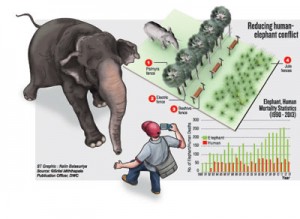News
Fences don’t work for elephants, say villagers but minister wants more in short term
None of the three solutions in practice for minimising human-elephant conflict are working, say vulnerable villagers, and the new Minister for Wildlife, Gamini Jayawickrema Perera, has asked for a report from officials of the 11 zones affected by the problem.
A committee consisting of government agents, assistant government agents and Grama Sevaka Niladharis have been appointed to investigate and submit a report by September 22.
“I have asked for details of the distance to be electrically fenced and the damage caused to human lives,” Mr. Perera said.His solution for the problem is threefold. He will erect more electrified fences to keep elephants away from human habitation in the short term.
He also hopes to build rapport between the villagers and the elephants by encouraging farmers to grow food crops along the fences for the animals. “This way both the humans and animals can live in harmony,” he said.
He will set up a fund from which affected farmers are compensated for the damage to their crops by elephants. “A crop insurance and a life insurance will be set up for the villagers,” he said.
| Unlawful leases on Wildlife land to be probed Wildlife Minister Gamini Jayawickrema Perera said he would look immediately into the reported issue of land belonging to the wildlife department being unlawfully leased from farmers by multinational companies to grow vegetables and fruit. |
A longer-term solution he proposes is to ask people to grow spiky lime and sesame (thala) bushes along the electric fences, saying the spikes in the two-foot shrubs would keep elephants away.
“Also, this would bring in an income for the villagers,” he said. This, however, is a long-term plan that would take around three years to yield results, the Minister acknowledged.
For many villagers living close to national parks reserved as sanctuaries for wild elephants, each day dawns with the fear of a marauding elephant invading their cultivated land and homes.
| Journalist trampled to death Journalist Priyantha Ratnayake was attacked and killed by an elephant on Tuesday while on assignment covering a story on wild elephants at Minneriya, Samagipura. |
Victims who have lost family members and their crops to the pachyderms complain that the government is not sufficiently addressing the problem.
They say electric fences around the protected area reserved for the animals are clearly not working and are demanding alternative solutions.
According to the Wildlife Department statistics there are 6,800 elephants in sanctuaries in addition to more in the wild.
The government, believing that electric fencing was the only solution to the problem, has spent millions of rupees on this but the elephants are surmounting the hurdle and are finding their way into the villages.
Environmentalists said the elephants have become accustomed to the electric shocks and are effortlessly crossing the boundaries. They said that there is an urgent need to look at alternative methods of restraining the animals.
Environmentalist and researcher Supun Lahiru noted that the reason elephants do not confine themselves to the space allocated to them is due to their habit of roaming long distances in search of food. They walk five to eight kilometres a day in search of food.
Statistics have revealed that most of the elephants are concentrated in the North-Western Province and that around 75 per cent of the population lives in the protected areas in the Wayamba region including the Wilpattu National Park and the Kahulla-Pallekelle and Mundel bird sanctuaries.
Environmentalists say the three methods used by the Department of Wildlife Conservation (DWC) to contain elephant-human conflict have proved futile because of the haphazard way in which they are carried out.
The translocation method, in which all elephants in one area are put in one location has not worked as this has deprived them of their home range. It has been found that they even walk 200-300km to come back to their usual habitat. “This happened in the Somawathie and Galgamuwa sanctuaries,” Mr. Lahiru said.
Another is the elephant driving method, by which herds consisting of females and calves are driven into demarcated areas. During this process the animals are shouted at, shot at sometimes with live bullets and scared into corridors with the use of fire-crackers.
Research has shown that the calves get used to this type of treatment and, when they become bulls, resist this type of treatment.
The last is the electric fencing which is proving to be expensive and useless.
Mr. Lahiru said that one way of circumventing the problem is to have the electric fences erected around the villages instead of around the elephant populated areas. This way, he said, the villagers can monitor the fence and repair any damage that may be caused.
He also said it was important to enrich the elephants’ habitat with sufficient food and water so that they do not have the need to stray into human settlement. Creating new habitat including in wildlife sanctuaries and national parks, had to be considered.
Additionally, in view of animal corridors being blocked by human settlement, there was a need to clear the path so the elephants could move around freely.
A DWC official speaking on the condition of anonymity said water resources in protected areas were running dry and there was an immediate need to clean them up.
He pointed out that the animals find the crops grown by encroaching villagers in cleared jungle, elephant habitat, to be appetising. “The watakka and banana plantations are very attractive to the elephants,” he said.
He said electric fences were only a psychological barrier to the elephants.


 Samigapura.
Samigapura.